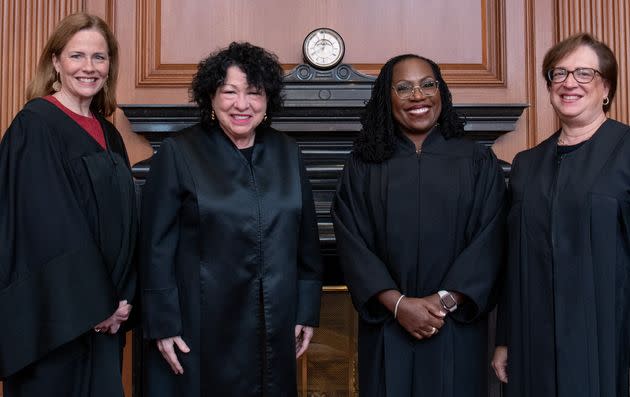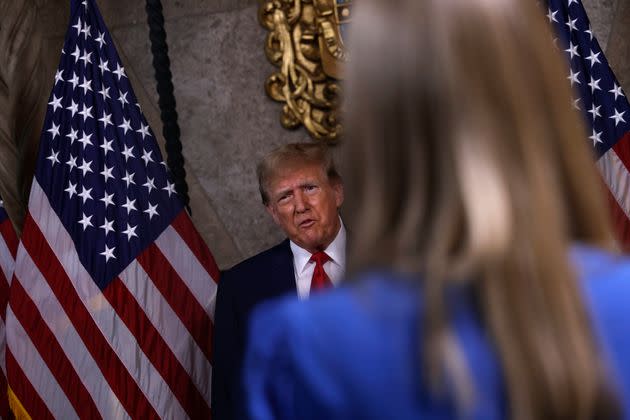The Key Disagreement In The Liberal Justices’ Concurrence On The Trump Ballot Ruling
- Oops!Something went wrong.Please try again later.
- Oops!Something went wrong.Please try again later.
- Oops!Something went wrong.Please try again later.
- Oops!Something went wrong.Please try again later.
- Oops!Something went wrong.Please try again later.
The U.S. Supreme Court issued a unanimous decision on Monday overturning a decision by the Colorado Supreme Court that found former President Donald Trump could be disqualified from appearing on the state’s ballot for his role in the Jan. 6, 2021, insurrection. But while all nine justices put their names to that decision, a bitter 5-4 divide lurked underneath.
The majority opinion allowed Trump to stay on the ballot in Colorado (and Maine and Illinois, where he had also been found ineligible) by arguing that states may only enforce Section 3 of the 14th Amendment ― the constitutional provision barring oath-breaking insurrectionists from future office ― for state offices but not federal ones. All of the justices agreed on this main point.
But three justices ― liberals Elena Kagan, Sonia Sotomayor and Ketanji Brown Jackson ― disagreed vehemently with the assertion by the five conservative justices ― John Roberts, Samuel Alito, Clarence Thomas, Neil Gorsuch and Brett Kavanaugh ― that Section 3 could only be enforced for federal offices by specific congressional legislation. Fellow conservative Amy Coney Barrett issued a separate concurrence that refrained from elaborating on her disagreement with the majority opinion, concluding “our differences are far less important than our unanimity.”
Invoking the court’s controversial decision in Bush v. Gore, which decided the razor-thin outcome of the 2000 election in favor of Republican George W. Bush, the liberal justices declared that the majority’s decision had gone too far by potentially closing off other avenues for federal courts and Congress to prevent insurrectionist candidates from gaining office.
“Even though ‘[a]ll nine Members of the Court’ agree that this independent and sufficient rationale resolves this case, five Justices go on,” the three liberals write in a concurrence that reads like a bitter dissent. “They decide novel constitutional questions to insulate this Court and petitioner from future controversy.”

The liberal concurrence took issue with the fact that the majority had not only ruled on whether the state of Colorado could enforce Section 3 against federal candidates but also on who could instead: namely, Congress, and only Congress, via legislation. In short, they argued, the decision removes power from the courts to rule on if someone was, in fact, an insurrectionist. The decision “forecloses judicial enforcement of that provision,” according to the liberals’ concurrence. Such enforcement could arise “when a party is prosecuted by an insurrectionist and raises a defense on that score,” they contended.
Such a situation could arise if someone brings a legal challenge to an action by a future President Trump, like, say, a declaration of emergency in order to federalize police officers to round up undocumented immigrants for deportation.
Similarly, it could negate any federal court review if Trump appointed anyone who engaged in the Jan. 6 plot to a federal office, such as former Assistant Attorney General Jeffrey Clark.
In doing this, the liberals argued, “the majority attempts to insulate all alleged insurrectionists from future challenges to their holding federal office.”
As the liberals noted, “nothing in Section 3’s text supports the majority’s view of how federal disqualification efforts must operate.” Instead, they argued, the majority relied on flimsy precedent and cherry-picked historical quotes to create a new precedent, making Section 3 all but unenforceable in the courts.
The majority cited an 1869 decision, issued by Chief Justice Salmon Chase while riding circuit, that argued that Section 3 required congressional authorizing legislation. But Chase’s decision in what was known as Griffin’s Case has been shown to be poorly reasoned and the result of his own personal political ambitions.

The liberals also countered the majority’s assertion that Congress passed the Enforcement Act in 1870 in order to give a path to enforce Section 3, noting that the majority cherry-picked quotes from Sen. Lyman Trumbell in his support for the bill.
“The majority also cites Senator Trumbull’s statements that Section 3 “‘provide[d] no means for enforcing’” itself,” the opinion said. “The majority, however, neglects to mention the Senator’s view that ‘[i]t is the [F]ourteenth [A]mendment that prevents a person from holding office,’ with the proposed legislation simply ‘affor[ding] a more efficient and speedy remedy’ for effecting the disqualification.”
The majority opinion’s requirement that “congressional legislation enforcing Section 3” on federal officeholders must “reflect ‘congruence and proportionality’” and be tailored “‘to remedying or preventing’ the specific conduct” prohibited by Section 3, the liberals noted, also keeps Congress from passing “general federal statutes requiring the government to comply with the law.”
What the court is asking of Congress is by no means clear. Does this mean that Congress cannot declare under the Electoral Count Reform Act that Trump’s electors are “not regularly given” due to his ineligibility under Section 3?
“If the majority in Trump v. Anderson wanted to foreclose the possibility of a post-election Section Three challenge to Donald Trump’s eligibility, then they did a poor job,” Gerard Magliocca, a law professor at Indiana University School of Law and one of the few Section 3 legal experts, wrote of the decision.
Barrett, the lone conservative to disagree with this part of the ruling, simply noted that she “would decide no more than that” states cannot enforce Section 3 for federal offices, but she added that she did not want to further inflame public passions around the court by loudly disagreeing with the majority.
“The majority’s choice of a different path leaves the remaining Justices with a choice of how to respond,” Barrett wrote. “In my judgment, this is not the time to amplify disagreement with stridency. The Court has settled a politically charged issue in the volatile season of a Presidential election. Particularly in this circumstance, writings on the Court should turn the national temperature down, not up.”
The court could have simply chosen to speak in a unified voice, but instead five justices chose to further narrow any enforcement of Section 3 while muddying the waters about how exactly Congress could act to protect the country from oath-breaking insurrectionists.
